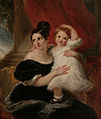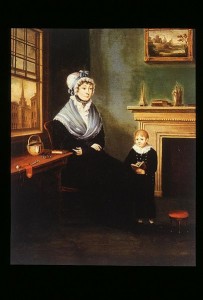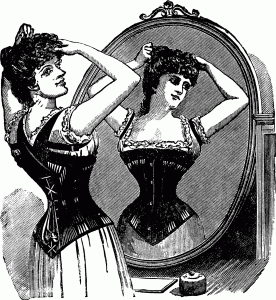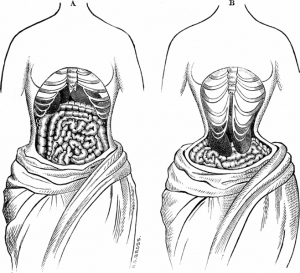Whitman, Motherhood, and Tight-Lacing



Whitman’s admiration for mothers was inspired by the love that he had for his own mother. This loves manifests itself in Whitman’s poetry especially in “As at thy Portals Also Death” in which Whitman seeks to immortalize himself and his mother through poetry.
“As at Thy Portals Also Death”
As at thy portals also death,
Entering thy sovereign, dim, illimitable grounds,
To memories of my mother, to the divine blending, maternity
To her, buried and gone, yet buried not, gone not from me,
(I see again the calm benignant face fresh and beautiful still,
I sit by the form in the coffin,
I kiss and kiss convulsively again the sweet old lips, the cheeks, the closed eyes in the
coffin;)
To her, the ideal woman, practical, spiritual, of all of earth, life, love, to me the best,
I grave a monumental line, before I go, amid these songs,
And set a tombstone here.
Whitman, consistent with the culture of his time, revealed an immense admiration for his mother. Myrth Jimmie Killingsworth writes that nineteenth century culture “encouraged a mystified and glorified mother-son bond” (39). One can see the intense love he has for his mother in his 1881 poem, “As at Thy Portals Also Death”. Lines 5-7 indicate the passionate love for mothers popular in the nineteenth century. Killingsworth describes, “The mother-son relationship took on an intensity bordering on the sexual in the novels of the day and in the bereavement literature” as exemplified by “an 1852 memorial narrative, a young boy about to die piteously tells his mother that he wishes ‘we could die with our arms around each other’s neck’” (Killingsworth 39-40).

This nineteenth century portrait of a mother exemplifies the middle class image of motherhood that Whitman so fiercely opposed. Myrth Jimmie Killingsworth writes that Whitman “rejects the middle-class ideal of the doll-like, fragile, yet morally superior female” (29). Whitman instead called mothers to be strong physically and mentally.
This view of motherhood was also espoused by reformers of the time seeking to empower the nation through physically fit mothers. Arthur Wrobel writes, “writers vigorously promoted the cause of women’s health by advocating calisthenics, proper diets, and of course clothing that fit the body rather than compelled the body to fit it” (12). Wrobel cites various authors and publications that advocated exercise and good health to prepare for motherhood and being a wife. Examples are: C. Morril, Physio-Medical Recorder, Peterson’s Ladies Magazine (1852), Marriage: Its History and Ceremonies by Lorenzo Niles Fowler, J.G. Spurzheim’s Education, and Treatise on the Physiological and Moral Management of Infancy by Andrew Combe. According to these reformers, the ideal woman for conceiving a child, was, “plump, full busted, and having a broad pelvis” (Wrobel 12).
The figure of the nineteenth century woman was under scrutiny. Reformers, seeking a strong nation also spoke out against tight lacing. Tight lacing they argued, “wreaked havoc on the internal organs of women, thereby endangering the environment of unborn babies” (Wrobel 11). Whitman decried the use of tight lacing in the Eagle. He writes the affects of tight lacing could affect, “mental temperament or nervous system, causing a continual fever of excitement, sleepless nights, and in many cases, confirmed mental derangement” (Wrobel 12-13). Whitman seeks the natural, physically fit woman in his poetry. Wrobel details Whitman’s feelings toward women and fashion quite harshly. He writes, “His [Whitman’s] diatribes against fashion were to continue to the end of his life, as he blamed women’s slavish devotion to fashion for the failure of America to evolve more perfect citizenry worthy of America’s future” (13).
The following pictures from Wiki Commons show an example of a corset and an anti-tight lacing picture which shows the “effects” on the internal organs after tight lacing. Historical evidence places tight lacing to have begun in 14th century Europe and ending in the early 20th century (Kunzle 6). David Kunzle’s Fashion and Fetishism A Social History of the Corset, Tight-Lacing and Other Forms of Body Sculpture in the West explains that, “tight-lacers were abused out of fear of women, and of female sexuality. The abuse was part of Victorian repression of sexuality, and particularly female sexuality, which was regarded as subversive of the social order. Tight-lacers were, like witches and prostitutes of old, social and sexual scapegoats” (Kunzle xviii). With this knowledge, it appears that Whitman’s admiration of motherhood prevailed over his desire to promote female sexuality…?


Works Cited
Killingsworth, Myrth Jimmie. “Whitman and Motherhood: A Historical View.” American Literature 54.1 (1982): 28. Print.
Kunzle, David. Fashion & Fetishism : Corsets, Tight-Lacing & Other Forms of Body-Sculpture. Stroud: Sutton, 2004. Print.
LeMaster, J. R., and Donald D. Kummings. Walt Whitman : An Encyclopedia. New York: Garland Pub., 1998. Print.
Whitman, Walt. Complete Poetry and Collected Prose. New York, N.Y: Literary Classics of the United States ; Distributed by Viking Press, 1982. Print.
Wrobel, Arthur. “‘Noble American Motherhood’: Whitman, Women, and the Ideal Democracy.” American Studies 21.2 (1980): 7-25. Print.
Pictures Used from Wiki Commons
http://commons.wikimedia.org
File:Moeder&Kind.jpgen kind 1 Mother and child | … half of the 19th century | Permission … Category:Cornelis Kruseman Category:Dutch Art in the Nineteenth Century
File:1835 Boston byJaneStuart.jpgDescription 1″Interior Scene” of mother and son at lesson, Boston, MA … edu/ic/collection/halttunen/Nineteenth_Century/Domesticity/8533
c1888.gif | Corset c1888 Image:Us000433095.gif | U. S. patent no. 433
File:ANatural – BTight lacing.pngB,Category:1884 Category:1885 Category:1888 Category:Anti-corset movement
Filed in Uncategorized No Responses yet